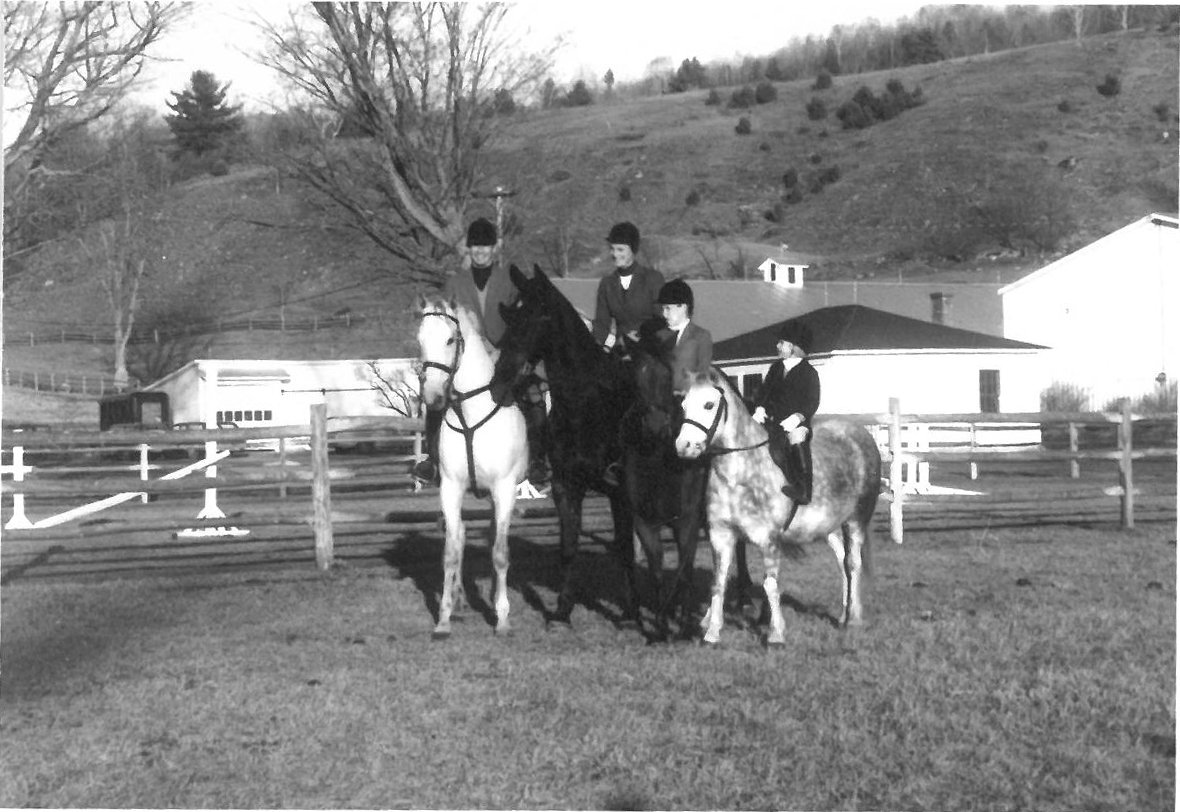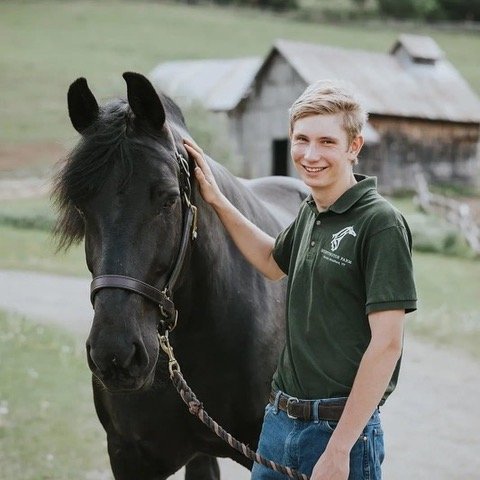Huntington Farm
Huntington Farm is central to Strafford, lying halfway between our two villages, near the geographical center of Strafford. In the ‘60s &‘70s, during the Read and Essie Perkins era, it was our local economic engine and an equestrian center of national renown. This essay first appeared in the 2022 Strafford Town Report.
Located halfway between our two villages, Huntington Farm has for most of the last 60 years played a significant role in the economic and social life of Strafford. Esther (Essie) and Read Perkins bought what was then a dairy farm from Richard and Blanche Prescott in 1964. Strafford’s population was at a low point after the closing of the Elizabeth Mine in 1958, and economic opportunities were severely limited.
Essie and Read were not strangers to Strafford. Essie’s family was part of the large Tyson/Wilson clan whose roots in town go back to the 1830s, when Issac Tyson started mining and smelting copper in Strafford.
Read and Essie had owned a horse farm in New Jersey where Essie gave riding lessons, but they were facing the pressures of development and looking for a new farm. Strafford with its more reasonable land prices seemed perfect. Moving up with them in 1964 was a teenager, Beth Reagan, who took riding lessons and had been their two daughters’ babysitter. Beth eventually married Dennis Preston, whose family has deep roots in the community. Beth Preston, longtime head of our FAST Squad, is just one of many who have enriched our community after being introduced to Strafford via Huntington Farm. Polly Poor was another young person who worked for the horse farm and went on to have a long and meaningful life in Strafford.
The farm continued the practice of boarding horses and giving riding lessons but soon developed into a boarding, training, and breeding facility for ‘event’ horses. At that time, the horse world in this part of Vermont was centered around Woodstock. ‘Eventing’ was just getting started in this country. ‘Eventing’ originated as the training of horses and riders for use in military exercises, and consists of three phases: dressage, cross-country and jumps. In 1969 Huntington Farm started hosting Horse Trials. The whole community became involved, and all proceeds went to the newly-formed Strafford Athletic Association. Volunteers were stationed at every jump along the cross-country and rated how well riders performed. Others helped out with a wide variety of tasks. It made for a long enjoyable time.as did the parties held at the farm to which the whole town was invited.
Huntington Farm drew other horse people to our community, most notably Denny and Mae Emerson, who bought a farm on the Brook Road. Denny was an Olympic-caliber rider and a highly regarded riding instructor with a national reputation. His Tamarack Hill Farm drew young people who sought to become serious riders.
Vi and Ned Coffin were another pair of horse enthusiasts who were drawn to Strafford by Huntington Farm’s growing reputation. Initially they boarded horses at Huntington Farm, before buying land and building a stable on Downer Forest Road and a home for their family in the Upper Village.
The Perkins’ Huntington Farm
The Perkins’ Huntington Farm really hit its stride in the 1970s when the United States Eventing Team came to train and school on the property. The pinnacle of what Huntington Horse Farm brought to Strafford was reached when Denny Emerson, Beth Perkins, and Tad Coffin all became part of the Olympic Equestrian team. Beth won a gold in the Pan American games, and at the 1976 Summer Olympics in Montreal, Tad won individual and team gold medals in Eventing. Strafford’s Olympic Equestrians were honored with a Welcome Home Celebration complete with parade, cake, and speeches on the common.
Huntington Farm ushered into Strafford not only the competitive horse world but also, under the guidance of Read Perkins, a number of businesses that employed a mix of local residents and newcomers, many of whom were destined to set roots in town.
The businesses under the umbrella of Joel S. Perkins & Son, a fourth-generation textile mill supply business, included Huntington Farm Fence Company, which made and installed split rail fencing; Huntington Farm Buildings, which specialized in barns, stables, run-in sheds and indoor riding arenas and training tracks; Fibar, a wood chip all-weather riding surface; and Huntington Farm Fiberglass, whose products included large fiberglass wheelbarrows, dressage letter cones, and chain to surround the arenas.
Some of those employed in these various enterprises included longtime residents Clayton Richardson, who first ran the fence company, and Jim Condict, who bought the fence business; Jim Durkee, Earl Silloway, Richard Moses, Don and Anne Prescott, Jerry Kill, Bob Murray, Jim Fullington, Russel Pixley, Ed Eastman, Terry Deirs, Polly Fifield, June Varney, Francis LaFleur, and Trent Sarii. Younger folk, many of whom moved here full time, included Jay, Bob, and Sherm Wilson and their cousin David Wilson, Blake Traendly, Eric Darnell, Peter Orgain, Peter Duveneck, Joe Silovich, Glenn Mitchell, Mel Dickenson, and David Harris. David took over the businesses after 10 years of apprenticeship in 1982, after the passing of Read. Arthur and Larry Robinson were involved with haying the fields.
Read’s many enterprises combined with Essie’s kindness, wit and good nature created opportunities for old and new residents alike to mix and get to know and respect one another. These interactions helped ease the transition in Strafford as new people moved into town and added new energy to our community. While working together on these jobs or volunteering on horse shows, many unlikely friendships developed outside the usual family and social circles. Read was elected to the Selectboard in 1969, the first non-native Vermonter to serve in this position in many decades, and held office until his passing.
Both Read and Essie died far too young, Essie in 1977 at age 51, and Read in 1982 at age 56. Their daughter Beth took over the farm for a year, but without the financial support of Read’s other businesses, it was difficult to continue. The farm was sold in 1983 to Ann Kitchel with financial assistance from the Upper Valley Land Trust and a significant local fundraising effort.
Kitchel took over the property at a time when ‘eventing’ was undergoing a lot of changes and many standards and regulations were being implemented. With a great deal of effort, she revamped the cross-country course to ensure the courses met with current standards. Ann continued with lessons, the breeding program, and the Trials. Huntington Farm remained popular in large part due to the unique challenge of their cross-country course, which is quite hilly and encompasses a wide variety of jumps. During her ownership, she provided a training ground for some of the biggest names in the sport, including Mara Depuy who grew up in Strafford and went on to ride in the 1996 Olympics.
Skylar Clemens
In 2021, Skylar Clemens purchased it from Kitchel, under whom he had been working for two years. Originally from Pennsylvania, Clemens’ family was looking for a change as the land around their farm became over-developed. Skylar moved with his family to Vermont during high school and fell in love with Vermont. Clemens now runs the farm with the help of Ann’s niece Pinky Tullar. The number of events has been greatly increased and with this new youthful energy has come a revitalization of the farm. While the horse trials themselves are not much of a money making operation, as in the past the farm is benefiting through the support of people in town and the wider area horse community. Recently Huntington introduced cross-country fence sponsorship and people immediately donated fences in honor of loved ones and family members. Tent-stabling during events was also made possible by a donation. While it may never again be the singular economic force in Strafford that it was the ’60s and ’70s, Huntington Farm under Skylar’s stewardship continues to be one of the central and cherished parts of our community.
Huntington Farm - 2022




